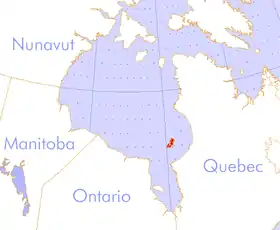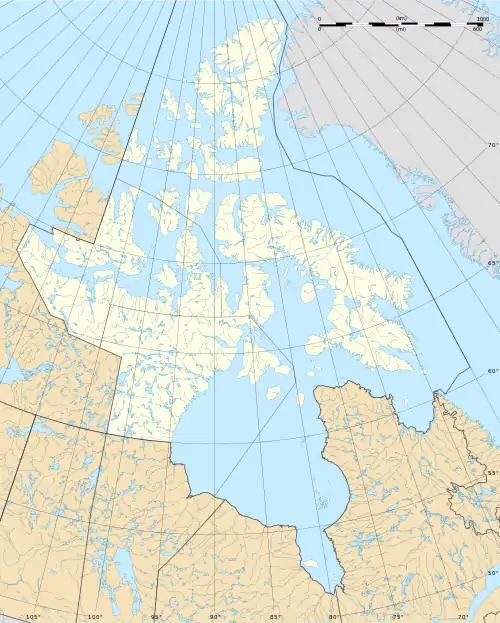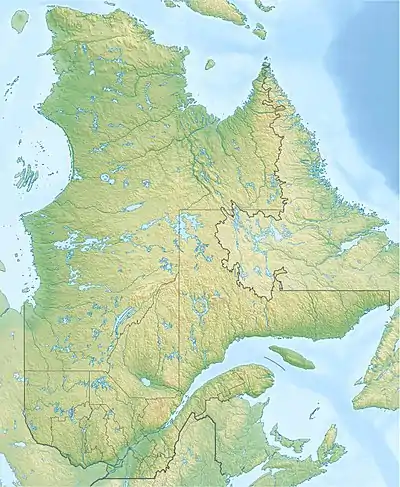Îles Belcher
Les îles Belcher (en inuktitut : Qikirtait) sont un archipel de la baie d'Hudson, au Canada. Les îles sont administrativement rattachées à la région de Qikiqtaaluk du territoire du Nunavut. La majorité de la population de l'archipel habite le village de Sanikiluaq, sur l'île Flaherty. Parmi les 1 500 îles et îlots de l'archipel, on retrouve également l'Île Kugong (en), l'île Tukarak (en), Radar Island et l'île Innetalling (en).
| Îles Belcher | |
 Localisation de l'archipel | |
| Géographie | |
|---|---|
| Pays | |
| Localisation | Baie d'Hudson (océan Arctique) |
| Coordonnées | 56° 20′ 00″ N, 79° 30′ 00″ O |
| Superficie | 2 896 km2 |
| Nombre d'îles | 1 500 |
| Île(s) principale(s) | Flaherty, Kugong (en), Tukarak (en), Innetalling (en) |
| Administration | |
| Territoire | |
| Région | Qikiqtaaluk |
| Démographie | |
| Plus grande ville | Sanikiluaq |
| Autres informations | |
| Découverte | Préhistoire |
| Fuseau horaire | UTC-5 |
| Île au Canada | |
Toponymie
L'archipel est nommé en l'honneur de l'amiral britannique Edward Belcher.
Géographie

Cet archipel a une superficie de 2 896 km2, une superficie supérieure à celle du Luxembourg.
Histoire
Différents sites archéologiques ont révélé des traces de la culture de Dorset et de la culture de Thulé, ce qui confirme que l'archipel est fréquenté depuis plusieurs siècles[1]. Henry Hudson repère les îles en 1610. Dans les années 1840, Thomas Wiegand, un employé de la Compagnie de la Baie d'Hudson, y mène une expédition. En 1915, le cinéaste Robert Flaherty y séjourne. Durant les années 1920, les îles sont arpentées par le ministère de l'Intérieur. Peu de temps après, la Compagnie de la Baie d'Hudson ouvre un poste de traite. Ce dernier sera en fonction jusque dans les années 1950, avec quelques interruptions[2].
En 1941, neuf personnes perdirent la vie lors d'un élan de fanatisme religieux mené par trois résidents, Charley Ouyérack, Peter Sala et sa sœur Mina[3] - [4].
Dans les années 1960, deux camps sont créés, au sud et au nord de l'île Flaherty. Le camp nord deviendra Sanikiluaq en 1976[5].
Notes et références
- Notice dans un dictionnaire ou une encyclopédie généraliste :
- Ressource relative à la géographie :
- (en-GB) « Sanikiluaq - Airinuit », sur www.airinuit.com (consulté le )
- « Welcome to Sanikiluaq », sur www.sanikiluaq.ca (consulté le )
- Radio-Canada.ca, « Le massacre des îles Belcher », sur ICI Radio-Canada Première, (consulté le )
- (en-CA) « When 'God' and 'Satan' battled in a barren land; the Belcher Islands Murders », sur Morton's Musings, (consulté le )
- « qtcommission.com/actions/GetPa… »(Archive.org • Wikiwix • Archive.is • Google • Que faire ?).
Voir aussi
Bibliographie
- Bell, Richard T. Report on Soapstone in the Belcher Islands, N.W.T. St. Catharines, Ont: Dept. of Geological Sciences, Brock University, 1973.
- Born, David O. "Eskimo Education and the Trauma of Social Change". Social Science Notes - 1, Northern Science Research Group, Department of Indian Affairs and Northern Development, Ottawa, January 15, 1970
- Caseburg, Deborah Nancy. Religious Practice and Ceremonial Clothing on the Belcher Islands, Northwest Territories. Ottawa: National Library of Canada = Bibliothèque nationale du Canada, 1994. (ISBN 0-315-88029-5)
- Flaherty, Robert J. The Belcher Islands of Hudson Bay Their Discovery and Exploration. Zug, Switzerland: Inter Documentation Co, 1960s.
- Fleming, Brian, and Miriam McDonald. A Nest Census and the Economic Potential of the Hudson Bay Eider in the South Belcher Islands, N.W.T. Sanikiluaq, N.W.T.: Brian Fleming and Miriam McDonald, Community Economic Planners, 1987.
- Guemple, D. Lee. Kinship Reckoning Among the Belcher Island Eskimo. Chicago: Dept. of Photoduplication, University of Chicago Library, 1966.
- Hydro-Québec, and Environmental Committee of Sanikiluaq. Community Consultation in Sanikiluaq Among the Belcher Island Inuit on the Proposed Great Whale Project. Sanikiluaq, N.W.T.: Environmental Committee, Municipality of Sanikiluaq, 1994.
- Jonkel, Charles J. The Present Status of the Polar Bear in the James Bay and Belcher Islands Area. Ottawa: Canadian Wildlife Service, 1976.
- Manning, T. H. Birds and Mammals of the Belcher, Sleeper, Ottawa and King George Islands, and Northwest Territories. Ottawa: Canadian Wildlife Service, 1976.
- Oakes, Jill E. Utilization of Eider Down by Ungava Inuit on the Belcher Islands. [Ottawa, Ont.]: Canadian Home Economics Journal, 1991.
- Richards, Horace Gardiner. Pleistocene Fossils from the Belcher Islands in Hudson Bay. Annals of the Carnegie Museum, v. 23, article 3. Pittsburgh: Carnegie Museum], 1940.
- Twomey, Arthur C., and Nigel Herrick. Needle to the North, The Story of an Expedition to Ungava and the Belcher Islands. Houghton Mifflin, 1942.


